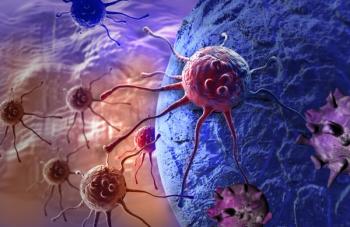
Pain Management in Cancer Patients at Risk of Opioid Abuse
In this interview we discuss pain management for cancer patients who are at high risk of opioid abuse.
Today we are speaking with Kathleen Broglio, APRN, DNP, palliative care specialist at the Dartmouth–Hitchcock Medical Center in New Hampshire, about pain management for cancer patients who are at risk for opioid abuse. Broglio and her colleagues discussed this topic at the Oncology Nursing Society (ONS) Congress, held May 4–7 in Denver.
-Interviewed by Anna Azvolinsky
Cancer Network:What are some of the best resources for nurses and clinicians on how to help their cancer patients manage pain? Are there recent guideline updates or novel approaches that are now being implemented?
Kathleen Broglio: There are a lot of different resources that are available to help clinicians manage pain. Those in oncology can always use the National Comprehensive Cancer Network, which has guidelines on how to manage pain for patients with cancer. Broadly speaking, so many resources are available on how we should manage pain in general, and I think it’s important that even those who are in oncology recognize the guidelines that have come out. For example, the Centers for Disease Control recently came out with guidelines on how to manage pain with opioids in those with chronic pain. This is not meant specifically for patients with cancer pain or palliative care needs, but about 30% of people with cancer who have no evidence of disease-survivors-still have ongoing pain that needs to be treated.
I think it is also important that all clinicians are aware of what is happening in the United States in terms of the opioid abuse crisis. In the past we’ve often said, “Well, we are not going to worry about it, these people have cancer, we don’t have to look at who might be at risk.” But what we are seeing now is that people with cancer have just as much risk for addiction, misuse, and abuse as those in the general population who are treated for chronic pain. I think that all prescribers should complete the Risk Evaluation and Mitigation Strategy training for opioid prescribing that is available through various websites-it’s free-to better understand how to safely prescribe opioids in this population.
Most conferences that focus on oncology will also have some sessions focused on pain, because it’s important for nurses and clinicians to know how to use multimodal analgesia to manage pain, especially with pain like chemotherapy-induced peripheral neuropathy that often plagues patients for years.
Cancer Network:In your presentation at ONS, you and your colleagues specifically discussed pain management for cancer patients who may have altered pain perception due to addiction or other causes. Can you talk about pain management in these types of patients?
Kathleen Broglio: I think what we really addressed during the conference is the whole issue that we need to really evaluate every patient we see for risk of misuse, opioid use disorder, or diversion. Really, everyone can be classified as a high-risk patient.
We go back to the idea of universal precautions for prescribing opioids. Universal precautions first came about in the age of AIDS, and we all donned gloves and protective mechanisms and assumed that anyone we treated could potentially be infected with HIV. And in the same way, I think we have to change our focus and say that any patient that we encounter may be at risk for substance misuse or abuse. This is not specific to an age group or an economic class, because it is a biological disorder that can happen to anyone.
When we talk about high-risk patients there are those that have a history of alcohol abuse as well as those that already have comorbid substance use disorder and may be on medication such as methadone or buprenorphine. We also have people that have had chronic pain prior to their cancer and have been on chronic opioid therapy for many years. They may have experienced what is called “central sensitization,” where they are less responsive to increasing opioid doses of analgesics and may require coanalgesics and nonpharmacologic treatment to help manage their pain.
When we think about how to identify these patients, the first thing is obviously having a very good history and looking at what type of pain this patient is experiencing, and really being able to identify if this is a nociceptive pain, a neuropathic pain, or an inflammatory pain, and if it is acute or chronic. Then, is the pain related to the cancer or is it premorbid chronic pain? That is the first level. The second is doing a detailed history about prior history of substance use or abuse, and this could even include people drinking alcohol for a long time, which may make them more at risk for future opioid abuse disorder.
There are a lot of risk screening tools that people can use to identify potential risk for opioid use disorder or substance use disorder. None of them, however, have been validated in the oncology population or in patients with serious illness-so that is a limitation-but they can still help the clinician identify that this person may be at risk for misuse.
Cancer Network: What is your general philosophy for approaching pain management in higher-risk patients who may require interventions for long-term pain management?
Kathleen Broglio: I think the first thing to really identify is what I talked about before-what type of pain is this patient experiencing? And when we are looking at the long term-is this person going to require long-term opioid therapy?
If a patient is at high risk after screening, we always check the prescription drug monitoring program-which is available in all 50 states-to know if this person is seeking out medications from more than one provider. We also do random urine drug screens to make sure patients are taking what is prescribed and that there is no presence of other drugs. These are some general things that we do in our palliative clinic for all patients on opioid therapy. But we also look at other, nonpharmacologic options such as exercise, physical therapy, occupational therapy, and massage therapy.
We also look at coanalgesics. Can this person with neuropathic pain be managed on anticonvulsants, antidepressants? Is their pain better managed on non-opioid medications? Again, when we are looking at the long term we want to find ways we can manage the patient’s pain through a multimodal pain approach vs just opioid therapy, which has been the mainstay when we think about treating cancer pain over the long term. Now we are recognizing that we have people that are living longer, that are long-term survivors, and we have to think about the long-term side effects of opioid medications over time. We previously thought these didn’t exist, but now we see that there are risks for abuses and also for hormonal changes that can impact function in the future.
Cancer Network:Thank you so much for joining us today, Kathleen.
Kathleen Broglio: Thank you very much.
Newsletter
Stay up to date on recent advances in the multidisciplinary approach to cancer.

















































































